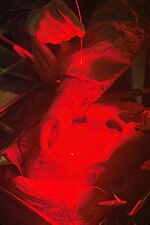Laser medicine


Laser medicine consists in the use of lasers in medical diagnosis, treatments, or therapies, such as laser photodynamic therapy,photorejuvenation, and laser surgery.
The word laser stands for "light amplification by stimulated emission of radiation".
History
The laser was invented in 1960 by Theodore Maiman, and its potential uses in medicine were subsequently explored. Lasers benefit from three interesting characteristics: directivity (multiple directional functions), impulse (possibility of operating in very short pulses) and monochromaticity.
Several medical applications were found among this new instrument. In 1961, just one year after the laser's invention, Dr. Charles J. Campbell successfully used a ruby laser to destroy an angiomatous retinal tumor with a single pulse. In 1963, Dr. Leon Goldman reported used to the ruby laser to treat pigmented skin cells and reported on his findings.
The argon ionized laser (wavelength: 488-514nm) has since become the preferred laser for the treatment of retinal detachment. The carbon dioxide laser was developed by Kumar Patel and others in the early 1960s and is now a common and versatile tool not only for medicinal purposes but also for welding and drilling, among other uses.
The possibility of using optical fiber (over a short distance in the operating room) from the year 1970 has opened many laser applications, in particular endocavitary, thanks to the possibility to introducing the fiber into the channel of an endoscope.
During this time, the argon laser began to be used in gastroenterology and pneumology. Dr. Peter Kiefhaber was the first to "successfully perform endoscopic argon laser photocoagulation for gastrointestinal bleeding in humans". Kiefhaber is also considered a pioneer in using the Nd:YAG laser in medicine, also using it to control gastrointestinal bleeding.
In 1976, Dr. Hofstetter employed lasers for the first time in urology.Thanks to laser dye, the late 1970s saw the rise of photodynamic therapy. (Dougherty, 1972)
Since the early 1980s, the applications have particularly developed and lasers have become indispensable tools not only in ophthalmology but also in gastroenterology and in facial and aesthetic surgery.
In 1981, Goldman and Dr. Ellet Drake, along with others, founded the American Society for Laser Medicine and Surgery to mark the specialization of certain branches of medicine thanks to the laser. In the same year, the Francophone Society of Medical Lasers (in French, Société Francophone des Lasers Médicaux) was founded for the same purpose and was first led by Maurice Bruhat.
After the end of the 20th century, the number of many centers dedicated to laser medicine have opened, first in the OCDE, after then more generally since the beginning of the 21st century.
The Lindbergh Operation was a historic surgical operation between surgeons in New York( United States) and doctors and a patient in Strasbourg (France) in 2001. Among other things they utilized the use of lasers.
Advantages
The laser presents multiple unique advantages that make it very popular among various types of practitioners.
- Due to its directional precision, a laser is used to precisely cut and cauterize all kinds of tissues without damaging neighboring cells. It's the safest technique and most precise cutting and cauterizing ever practiced in medicine.
- Laboratories make extensive use of lasers, especially for spectroscopy analysis and more generally for the analysis of biochemical samples. It makes it possible to literally "see" and more quickly determine the composition of a cell or sample on a microscopic scale.
- The electrical intensity of a laser is easily controllable in a safe way for the patient, but also variable at will, which gives it a very wide and still partially explored range of uses (in 2021).
Disadvantages
The principal disadvantage is not medical but rather economic: its cost. Although its price has dropped significantly in developed countries since its inception, it remains more expensive than most other common technical means due to materials, the technicality of the equipment necessary for the operation of any laser therapy, as well as the fact that it requires only certain specific training.
For example, in France (as in other countries with a social security system), dental, endodontal or periodontal laser treatment is classified outside the nomenclature and therefore not reimbursed by social security.
Lasers
Lasers used in medicine include in principle any type of laser, but especially the following:
- CO2 lasers, used to cut, vaporize, ablate and photo-coagulate soft tissue.
- diode lasers
- dye lasers
- excimer lasers
- fiber lasers
- gas lasers
- free electron lasers
- semiconductor diode lasers
Applications in medicine
Examples of procedures, practices, devices, and specialties where lasers are utilized include the following:
- angioplasty
- cancer diagnosis
- cancer treatment
- Dentistry
- cosmetic dermatology such as scar revision, skin resurfacing, laser hair removal, tattoo removal
- dermatology, to treat melanoma
- frenectomy
- lithotripsy
- laser mammography
- medical imaging
- microscopy
- ophthalmology (includes Lasik and laser photocoagulation)
- optical coherence tomography
- optogenetics
- prostatectomy
- plastic surgery, in laser liposuction, and in treatment of skin lesions (congenital and acquired) and in scar management (burns and surgical scars)
- surgery, to cut, ablate, and cauterize tissue
See also
- Dental laser
- Endovenous laser therapy
- Laser-assisted new attachment procedure
- Laser surgery
- Light therapy
- Low level laser therapy
- Photodynamic therapy
- Photomedicine
External links
![]() Media related to Laser medicine at Wikimedia Commons
Media related to Laser medicine at Wikimedia Commons
| Types of lasers | |
|---|---|
| Laser physics | |
| Laser optics | |

